Around 60 species are listed as British but others are occasionally imported in timber.
Cerambycids usually live in wood, some are monophagous while others are more general feeders, some attack herbaceous plants e.g. Phytoecia and Agapanthia. In the UK their commercial impact is negligible as most larvae feed on rotting or fallen timber and in this respect they may be considered beneficial; old stumps are rapidly broken down by e.g. Rhagium or Arhopalus. Hylotrupes can be a nuisance as its larvae develop in the structural timber in houses. Many species feed as adults, Laminae feed on stems or leaves while Lepturinae are often seen on flowers feeding on pollen. Some are usually nocturnal e.g. Prionus and come to light. Copulation occurs on flowers or in the host plant and eggs are laid in bark crevices, cracks in timber or old burrows, in herbaceous stems or sometimes in the ground around the host. Egg cavities are sometimes excavated with the mandibles or holes bored with the ovipositor.
Larvae attack wood of all sizes and are often remarkably resistant to dessication or waterlogging. This stage generally takes 2 or 3 years, rarely less, but in cases where they live in seasoned wood this can be prolonged to five years or longer; adult Eubria have emerged from furniture years after the timber was imported. Pupation usually occurs under bark or in the outer layer of xylem, sometimes in the soil in earth cocoons. many pupate in the autumn and overwinter as adults within the pupal cell.
Many species e.g. Prionus, stridulate when handled and some produce characteristic scents e.g. Aromia and Agapanthia which can be a guide to their presence.
The works by Joy and Duffy work well with our list but several species are omitted, the more recent work by Bily and Mehl is more comprehensive, excluding only Anoplodera rufa which was recorded once in 1860. A large number of foreign species have occasionally been introduced but are not established, many of these are described by Hickin, see also Hinton H.E. 1948 Ent. Mon.Mag 83:284-289. The series of papers by Kaufmann, R.R. Uhtoff- in the Ent.Rec J. Var. between 1987 and 1992 should be consulted for the status and some coverage of the ecology of many of our native species.
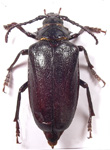
Prionus
coriarius
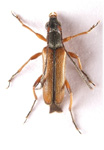
Alosterna
tabacicolor
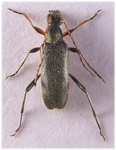
Grammoptera
ruficornis

Grammoptera
ruficornis
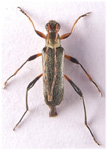
Grammoptera
ruficornis
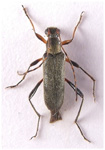
Grammoptera
ruficornis
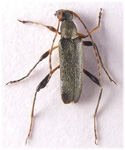
Grammoptera
ruficornis
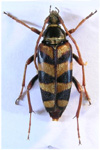
Leptura
aurulenta
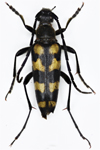
Leptura
quadrifasciata

Pseudovadonia
livida
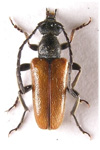
Pseudovadonia
livida
Rhagium
bifasciatum

Rutpela
maculata

Rutpela
maculata

Rutpela
maculata

Rutpela
maculata

Rutpela
maculata

Stenocorus
meridianus

Stenurella
melanura

Stenurella
melanura

Stictoleptura
scutellata

Anaglypta
mysticus

Clytus
arietis

Clytus
arietis

Clytus
arietis
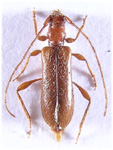
Obrium
brunneum
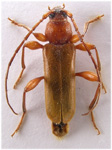
Phymatodes
testaceus

Poecilium
alni
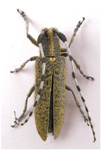
Agapanthia
villosoviridescens

Leiopus
nebulosus

Phytoecia
cylindrica
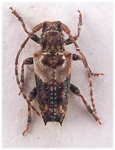
Pogonocherus
hispidus

Tetrops
praeustus